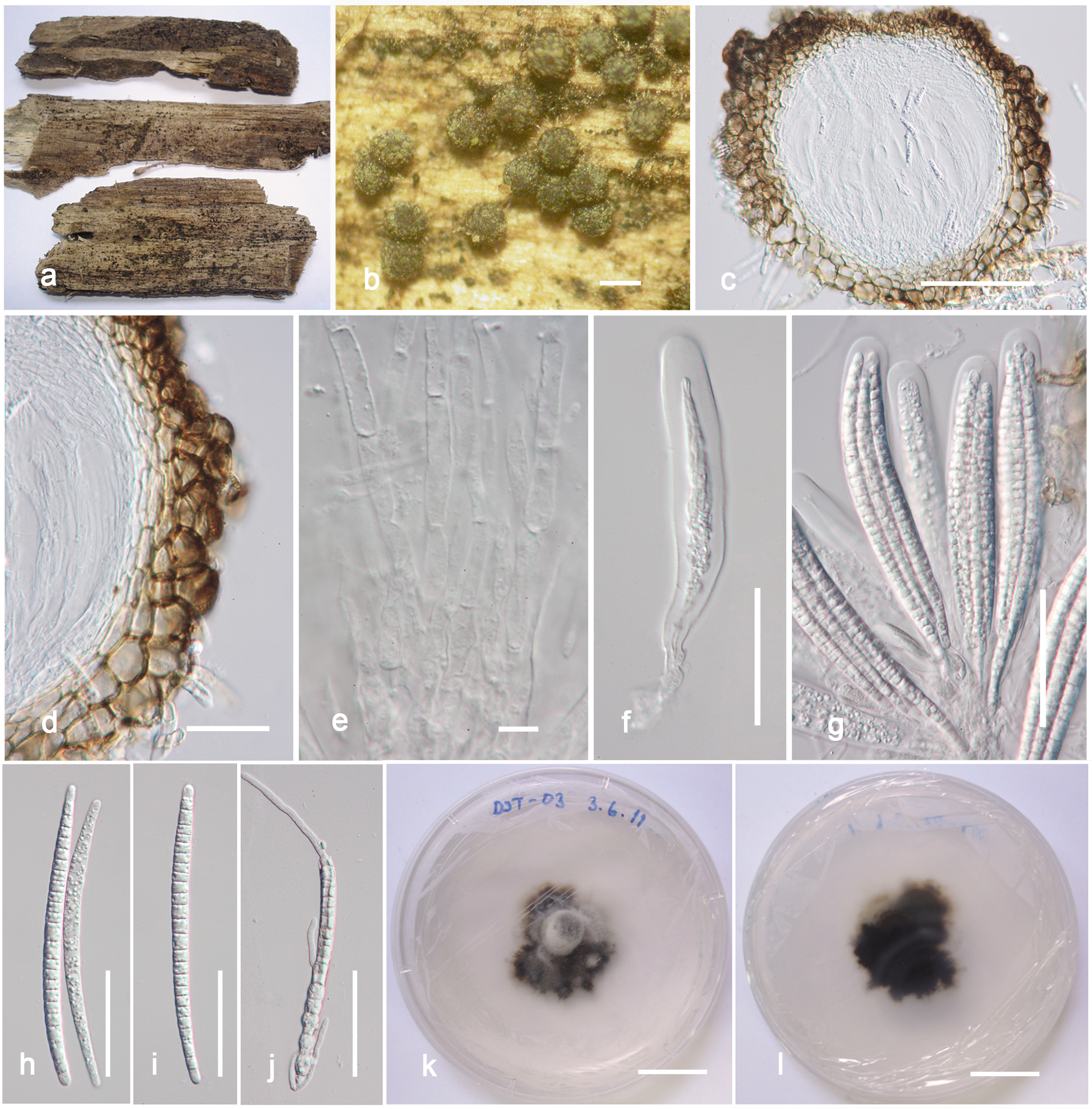Helicoma miscanthi (W.H. Hsieh, Chi Y. Chen & Sivan.), Boonmee & K.D. Hyde, comb. nov.,Index Fungorum numbeter: IF550637.
≡ Tubeufia miscanthiW.H. Hsieh, C.Y. Chen & Sivan., Mycol. Res. 102: 234 (1978)
Saprobicon dead wood. Sexual state:Ascomata 285–358(-373) µm high × 299–339(-386)µmdiam. (= 330 × 334 µm), superficial, solitary, scattered, globose-subglobose to ovate, flat to slightly shrunken on apex, lacking obvious setae, hyphae developing from ascomatal base on substrate, brown to dark brown when fresh, with a waxy covering on ascomal wall, pale brown when dry, darkened at centre, ostiolate. Peridium 51–58 µm wide, comprising several layers of brown to red brown cells of textura angularis. Hamathecium comprising numerous,ca. 3–4 µm wide,long filiform, septate, unbranched, hyaline pseudoparaphyses. Asci (142-)154–188(-194) × 19–26(-30) µm (= 172 × 24 µm, n = 20), 8-spored, bitunicate, cylindric-clavate, rounded at apex, mostly apedicellate, ocular chamber not observed. Ascospores (122-)131–165(-187.5) × 7–10µm ( = 147 × 9 µm, n = 20), fasciculate, cylindric-clavate, elongate, tapering towards rounded ends, slightly curved, 19–23(-25)-septate, slightly constricted, hyaline, with minutely globose cells, smooth-walled. Asexual state: Unknown.
Cultural characteristics: Ascospores germinating on MEA within 12 h and germ tubes produced from both ends. Colonies growing on MEA slowly, less than 5 mm in 7 days at 28C, slightly effuse, undulate to fimbriate at margin, dark, with white or pale brown aerial mycelium, asexual spores not formed within 60 days.
Material examined: THAILAND, Chiang Mai, Muang, Huai Kok Ma, Doi Su Thep, N18°48.365′ E98°54.522′, elev. 1015 msl., on dead wood of an unidentified tree, 21 April 2011, Saranyaphat Boonmee, DST-03 (MFLU 11–0134, epitype designated here; PDD 104453, iso-epitype), ex-type living culture = MFLUCC11–0375 = BCC 52033 = ICMP 20072.
Notes: One fresh tubeufia-like specimen with globose, light-coloured ascomata, numerous pseudoparaphyses, cylindrical, elongated asci and cylindrical, many septate, hyaline ascospores is identical with Tubeufia miscanthi (Hsieh et al. 1998). Tubeufia miscanthi was transferred to Taphrophila (T. miscanthi) by Réblová and Barr (2000) as it has elongate fusiform and fasciculate ascospores arranged in the ascus. However, Tubeufia miscanthi is morphologically different from the type species Taphrophila cornu-capreoli (Scheuer 1988; Hsieh et al. 1998). Our data indicates that Taphrophila miscanthi should be referred to Helicoma as it lies in Clade A, supported with 95% BS and 1.00 PP (Fig. 2). Samuels et al. (1979), and Barr (1980) considered T. miscanthi to be identical to T. paludosa but this is not supported here. We epitypify this namehere with the new collection from Thailand.
Fig. 1 Helicoma miscanthi (MFLU11–0134, epitype). a Herbarium specimen. b Ascomata on substrate. c L.S. of ascoma. d Peridium. e Pseudoparaphyses. f, g Asci. h, i Ascospores. j Germinating ascospore. k, l Colonies on MEAfrom surface and reverse. Scale bars: b-c=100µm, d=40µm, e=5µm, f-j=50µm, k-l=10mm

